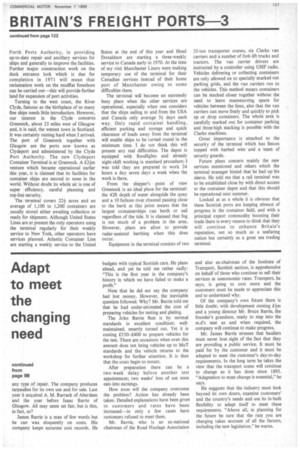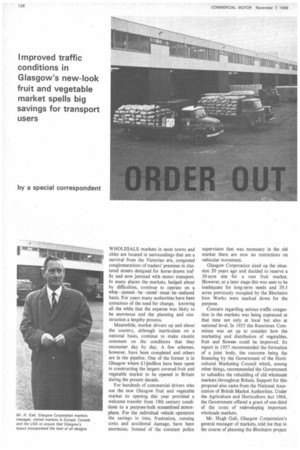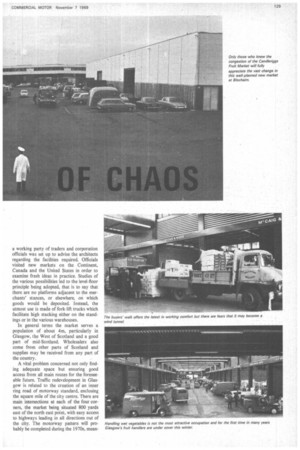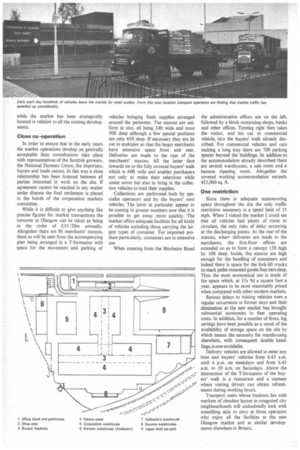Adapt to meet the changing need
Page 129

Page 130

Page 131

Page 132

If you've noticed an error in this article please click here to report it so we can fix it.
continued from page 98 any type of repair. The company produces tarpaulins for its own use and for sale. Last year it acquired A. M. Barrack of Aberdeen and the year before Isaac Barrie of Glasgow. All may seem set fair, but is this, in fact, so?
James Barrie is a man of few words but he can wax eloquently on costs. His company keeps accurate cost records. He budgets with typical Scottish care. He plans ahead, and yet he told me rather sadly: "This is the first year in the company's history in which we have failed to make a profit."
Note that he did not say the company had lost money. However, the inevitable question followed. Why? Mr. Barrie told me that he had under-estimated the cost of preparing vehicles for testing and plating.
The John Barrie fleet is by normal standards in excellent condition; wellmaintained, smartly turned out. Yet it is costing £3504400 to prepare vehicles for the test. There are occasions when even this amount does not bring vehicles up to MoT standards and the vehicle returns to the workshop for further attention. It is then that the costs begin to mount.
After preparation there can be a two-week delay before another test appointment; two weeks' loss of use soon eats into earnings.
How soon will the company overcome the problem? Action has already been taken. Detailed explanations have been given to customers and rates have been increased—in only a few cases have customers refused to meet them.
Mr. Barrie, who is an ex-national chairman of the Road Haulage Association and also ex-chairman of the Institute of Transport, Scottish section, is apprehensive on behalf of those who continue to sell their services at uneconomic rates. Transport, he says, is going to cost more and the customers must be made to appreciate this and to understand why.
Of the company's own future there is little doubt; with development costing i+m and a young director Mr. Bruce Barrie, the founder's grandson, ready to step into the m.d's seat as and when required, the company will continue to make progress.
Mr. James Barrie stresses that hauliers must never lose sight of the fact that they are providing a public service. It must be paid for by the customer and it must be adapted to meet the customer's day-to-day requirements. In the long term he takes the view that the transport scene will continue to change as it has done since 1895. "Adaptation to meet change is essential," he says.
He suggests that the industry must look beyond its own doors, examine customers' and the country's needs and use its in-built flexibility to adapt itself to meet these requirements. "Above all, in planning for the future be sure that the rate you are charging takes account of all the factors, including the new legislation," he warns. WHOLESALE markets in most towns and cities are located in surroundings that are a survival from the Victorian era, congested conglomerations of traders' premises in cluttered streets designed for horse-drawn traffic and now jammed with motor transport. In many places the markets, hedged about by difficulties, continue to operate on a what cannot be cured must -be-endured basis. For years many authorities have been conscious of the need for change, knowing all the while that the expense was likely to be enormous and the planning and construction a lengthy process.
Meanwhile, market drivers up and about the country, although inarticulate on a national basis, continue to make caustic comment on the conditions that they encounter day by day. A few schemes, however, have been completed and others are in the pipeline. One of the former is in Glasgow where £1 +million have been spent in constructing the largest covered fruit and vegetable market to be opened in Britain during the present decade.
For hundreds of commercial drivers who use the new Glasgow fruit and vegetable market its opening this year provided a welcome transfer from 19th century conditions to a purpose-built streamlined atmosphere. For the individual vehicle operators the savings in time, frustration, running costs and accidental damage, have been enormous. Instead of the constant police supervision that was necessary in the old market there are now no restrictions on vehicular movement.
Glasgow Corporation sized up the situation 20 years ago and decided to reserve a 10-acre site for a new fruit market. However, at a later stage this was seen to be inadequate for long-term needs and 29.5 acres previously occupied by the Blochairn Iron Works were marked down for the purpose.
Concern regarding serious traffic congestion in the markets was being expressed at that time not only at local but also at national level. In 1955 the Runciman Committee was set up to consider how the marketing and distribution of vegetables, fruit and flowess could be improved. Its report in 1957 recommended the formation of a joint body, the outcome being the financing by the Government of the Horticultural Marketing Council which, among other things, recommended the Government to subsidize the rebuilding of old wholesale markets throughout Britain. Support for this proposal also came from the National Association of British Market Authorities. Under the Agriculture and Horticulture Act 1964, the Government offered a grant of one-third of the costs of redeveloping important wholesale markets.
Mr. Hugh Galt, Glasgow Corporation's general manager of markets, told me that in the course of planning the Blochairn project a working party of traders and corporation officials was set up to advise the architects regarding the facilities required. Officials visited new markets on the Continent, Canada and the United States in order to examine fresh ideas in practice. Studies of the various possibilities led to the level-floor principle being adopted, that is to say that there are no platforms adjacent to the merchants' stances, or elsewhere, on which goods would be deposited. Instead, the utmost use is made of fork-lift trucks which facilitate high stacking either on the standings or in the various warehouses.
In general terms the market serves a population of about 4m, particularly in Glasgow, the West of Scotland and a good part of mid-Scotland. Wholesalers also come from other parts of Scotland and supplies may be received from any part of the country.
A vital problem concerned not only finding adequate space but ensuring good access from all main routes for the foreseeable future. Traffic redevelopment in Glasgow is related to the creation of an inner ring road of motorway standard, enclosing the square mile of the city centre_ There are main intersections at each of the four corners, the market being situated 800 yards east of the north east point, with easy access to highways leading in all directions out of the city. The motorway pattern will probably be completed during the 1970s, mean while the market has been strategically located in relation to all the coming developments.
Close co—operation In order to ensure that in the early years the market operations develop on generally acceptable lines consultations take place with representatives of the Scottish growers, the National Farmers Union, the importers, buyers and trade unions. In this way a close relationship has been fostered between all parties interested in work on the site. If agreement cannot be reached in any matter under dispute the final settlement is placed in the hands of the corporation markets committee.
While it is difficult to give anything like precise figures for market transactions the turnover at Glasgow can be taken as being in the order of £1-5 /20m annually. Altogether there are 86 merchants' stances, these as will be seen from the accompanying plan being arranged in a T-formation with space for the movement and parking of
vehicles bringing fresh supplies arranged around the perimeter. The stances are uniform in size, all being 24ft wide and most 901t deep although a few special positions are only 45ft deep. If necessary they are let out in multiples so that the larger merchants have extensive space front and rear. Deliveries are made to the rear of the merchants' stances. All the latter face inwards on to the fully covered buyers' walk which is 60ft wide and enables purchasers not only to make their selections while under cover but also to bring in the collection vehicles to load their supplies.
Collections are performed both by specialist operators and by the buyers' own vehicles. The latter in particular appear to be-coming in greater numbers now that it is possible to get away more quickly. The market offers adequate facilities for all kinds of vehicles including those carrying the largest types of container. For imported produce particularly, containers are in extensive use.
When entering from the Blochaim Road the administrative offices are on the left, followed by a block containing shops, banks and other offices. Turning right then takes the visitor, and his car or commercial vehicle, into the buyers' walk already described. For commercial vehicles and cars making a long stay there are 700 parking spaces beyond the buildings. In addition to the accommodation already described there are several warehouses, a sale room and a banana ripening room. Altogether the covered working accommodation exceeds 425,000 sq. ft.
One restriction Since there is adequate manoeuvring space throughout the site the only traffic restriction necessary is a speed limit of 15 mph. When I visited the market I could see that all vehicles had plenty of room to circulate, the only risks of delay occurring at the discharging points. At the rear of the stances, where. deliveries are made to the merchants, the first-floor offices are extended so as to form a canopy 15ft high by 10ft deep. Inside, the stances are high enough for the handling of containers and indeed there is space for the fork-lift trucks to stack pallet-mounted goods four tiers deep. Thus the most economical use is made of the space which, at 15s 9d a square foot a year, appears to be most reasonably priced when compared with other modern markets.
Serious delays to visiting vehicles were a regular occurrence in former days and their elimination at the new market has brought substantial economies in fleet operating costs. In addition, for a number of firms, big savings have been possible as a result of the availability of storage space on the site by which means the necessity for warehousing elsewhere, with consequent double handlings,is now avoidable.
Delivery vehicles are allowed to enter any time and buyers' vehicles from 6.45 a.m. until 4 p.m. on weekdays and from 6.45 a.m. to 10 a.m. on Saturdays. Above the intersection of the T-formation of the buyers' walk is a restaurant and a canteen where visiting drivers can obtain refreshments during working hours.
Transport users whose business lies with markets of obsolete layout in congested city neighbourhoods will undoubtedly look with something akin to envy at those operators who enjoy all the facilities at the new Glasgow market and at similar developments elsewhere in Britain.




































































































































































































































